
A week in the Big Apple shaped around 2 Broadway openings, coupled with coinciding with the Tribeca Film Festival, could only be exciting. In fact, a distinct roller-coaster theme emerged during the week, with ups and downs from temperature to emotions. It began with reading in the Times about development plans for the Staten Island waterfront, including the world’s largest roller coaster. Our destination for the first night of our stay was Staten Island, to visit Steve’s sister Sarah and her husband Aaron. They moved away from the St. George area of the Island near the ferry terminal last year and spent much of the prior year renovating a charming clapboard house on a quiet street where all the neighboring houses date from 1923.
Another roller coaster, this time at Coney Island, was also memorably featured in one of our favorite films of the week from the Tribeca Film Festival, the 1928 silent “Speedy,” featuring the adorable Harold Lloyd.
Then there was the emotional roller coaster connected with attending opening night of Doctor Zhivago. The show itself wrung copious tears from me, followed by the anxiety of waiting for the reviews.
Finally, we saw the actual Coney Island roller coasters with Sarah and Aaron on our way back to JFK.
Packing for this trip presented more than the usual logistical challenges-break our long-standing rule of always carrying on luggage for non-diving trips, send evening clothes east in advance, rent evening clothes? Attire for Fun Home, opening on Sunday, April 20, was “festive,” so that presented no particular difficulties. For Doctor Zhivago on Tuesday, April 22, the initial dress plan was black tie, trickier to manage carrying-on. By the time the actual invitation came, the dress code had been downgraded to “festive cocktail.” I was still a little skeptical about carrying on, but eventually managed it, trying on multiple combinations Friday night before departure, eventually coming up with 2 outfits coordinating with the same pair of ruby slippers (low-heeled Ferragamo red patent pumps) and a red origami Kao Pao Shu clutch made of car-strap material. I selected 2 knit dresses and 2 evening coats, rolled them as small as they would go and hoped for the best.
Steve’s youngest sister, Sarah, a nurse in lower Manhattan, and her theater district firefighter husband, Aaron, picked us up at JFK late Saturday afternoon and off to Staten Island we went for our first night. Sarah and Aaron had spent much of the prior year renovating their new house. Their elbow grease had created a wonderfully welcoming and comfortable environment, notably the guest room and an addictive suspended seat hung from a large tree in the backyard.
For dinner, we walked down the street a few blocks to a very popular German restaurant. Although Saturday night, there was a still-open nail salon next door, so I popped my head in and made an appointment for the following morning.
The salon was surprisingly busy for a Sunday morning at 10 am, but a bargain at $24 for a very respectable manicure and pedicure.
For lunch, we scored a table on the sunny terrace at a perennial favorite, Royal Crown bakery, where Steve and I shared scrumptious eggplant parmesan and grilled eggplant, mozzarella and broccoli rapini sandwiches on panini bread.
Steve and Aaron transferred us to our home for the week, the Marlton Hotel in the West Village, the gentle way, by car, with Sarah continuing on uptown to drop Aaron at work. We had hoped to check in early, but had to cool our heels hanging out in the inviting lobby and checking out the nearby stores, including CB Bigelow apothecary, filled with a surprising number of products for which we developed a “need.”
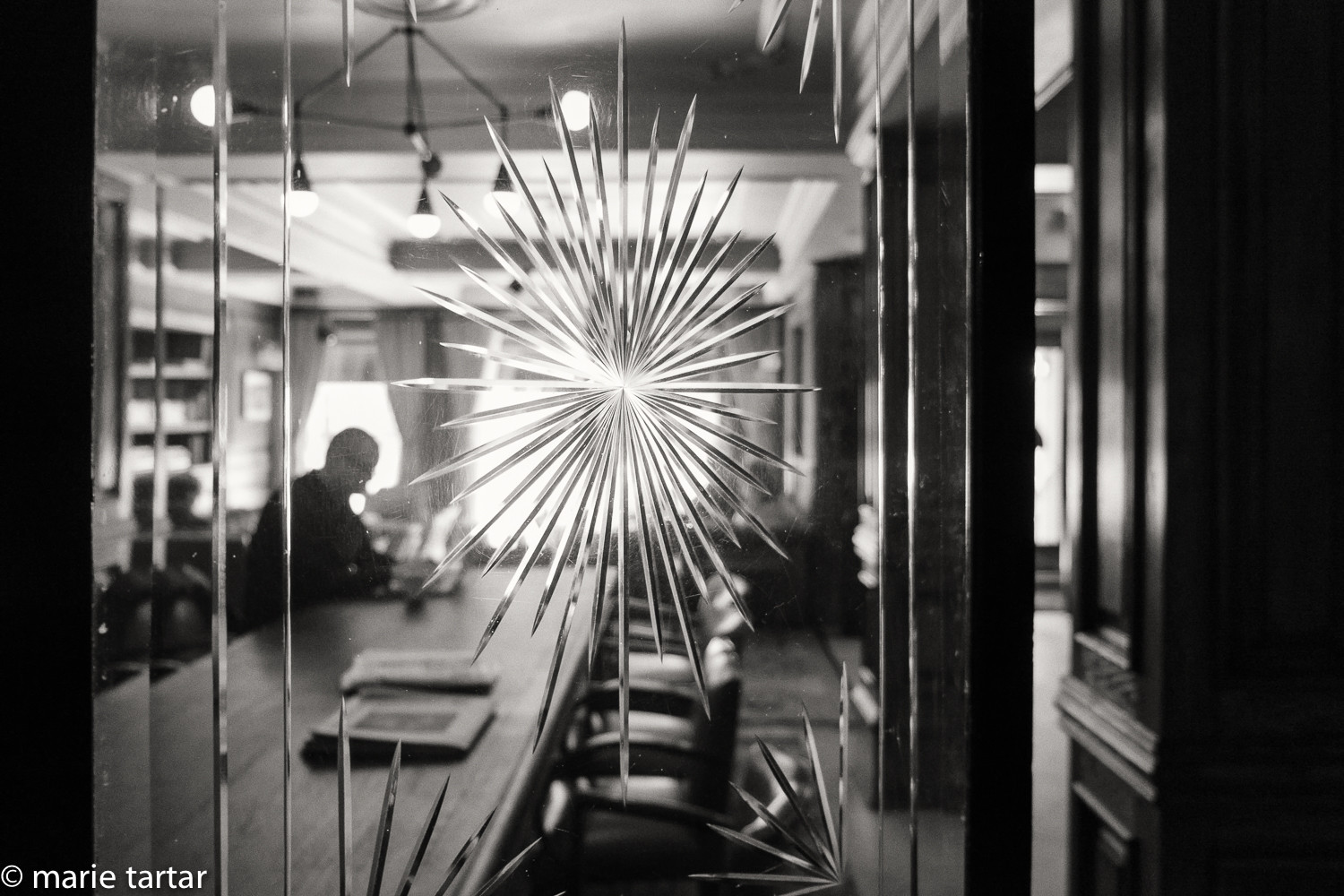
The Marlton lobby is a comfortable living room away from home to hole up with a laptop, have a coffee or have an informal business meeting.
The Marlton has a historic past as the Marlton House. Constructed in 1900, it provided single room occupancy housing for writers and actors for a large segment of its history. Jack Keroauc reportedly lived there while writing The Subterraneans. Other notable residents included Mickey Rourke, Julie Andrews, and Valerie Solanas, who was living there when she shot Andy Warhol. I was working with Vivian one day, who mentioned she had had a nice lunch at the restaurant, Margaux. The rooms looked nice on the Internet and the location was superb, on the edge of the West Village, near where my sister lives.
For the Fun Home opening, I wore a black knit sleeveless dress (Adrienne Vittadini, dating from residency in the late 1980s), topped with a red embroidered Prada evening coat.
To stave off hunger during the show, we met up before the show with friends and fellow San Diegans, Ralph and Gail, Lucille and Ron, and met Jeri and Don, at convenient-to-the-theatre Bar Centrale. The quiet Art Deco theatre district hideaway is a favorite for its inviting spaces and quiet buzz. The small plates are dependably good, including roasted asparagus, shrimp and Chinese mushroom dumplings, and other light yet substantial choices.
What does opening night on Broadway look like? The house was packed, with the Fun Home crowd more “dressed” than a regular night at the theatre. This crowd also appeared more diverse in age and orientation than a “regular” night on Broadway, with gay and lesbian fans more represented. There was a generalized nervous tension and excitement in the air. Exiting the restroom as I waited in the line before the intermission-less show was Alison Bechdel herself, literary heroine of the hour. I loved Fun Home, the autobiographical family “tragicomedy” graphic novel she wrote about growing up with her controlling closeted gay father in rural Pennsylvania, the unlikely source material for the show. The transformation of a graphic novel to the stage was accomplished by the ingenious means of having 3 actresses of different ages depict Alison as a 9 year old, as an Oberlin college coed and as a 43 year old lesbian cartoonist thinking back on her childhood and her realization in college that she is a lesbian. She regards her father’s death, being struck by a train, as a suicide, occurring shortly after her coming out to her parents and her mother’s request for a divorce.
I found the show emotionally very affecting. Apart from the groundbreaking themes of sexual identity, I personally related to the scene (Telephone Wire) in which Alison, home from college with her first girlfriend, goes for a drive with her father. The awkward silences, the wanting to bridge the inarticulate gap between parent and child, the longing for insight into your parent’s interior life and past, the yearning to make the most of rare opportunities for connection, are all poignant moments to which anyone can relate and particularly resonated for me.
The after party at Umbo near Grand Central Station was like any big party: lines for drinks and food, a search for seats, much kissing and greeting and congratulations. We enjoyed chatting with Todd, a movie producer whose wife Amy co-wrote the lyrics for Zhivago. We learned he produced a zany movie musical we just saw at the Sedona Film Festival in February, Lucky Stiff, directed by La Jolla Playhouse’s Christopher Ashley.
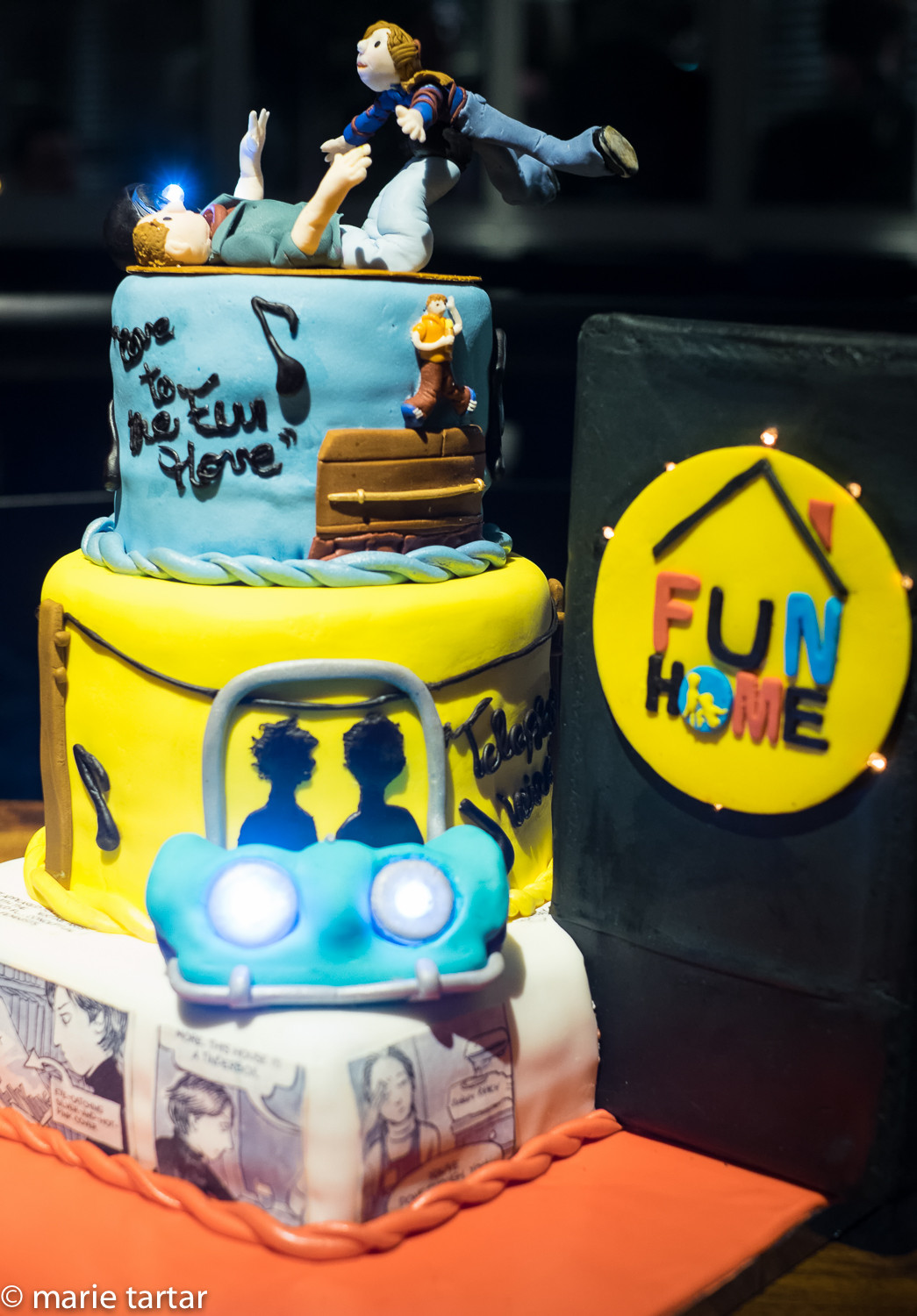
Scenes from Fun Home recapitulated on the cake at the opening night after party: from top, young Alison and her father play airplane; coffin at the Fun Home (in which the children hide and play); Alison and her father in the car the last time she saw him, searching for the right words to connect; scenes from the original graphic novel on which the play is based.
Monday was grey and steadily raining, the kind of morning inducing lingering over breakfast. We did eventually head out into rain, which gusted up under our umbrellas, making us duck into the subway for a distance we would normally walk.

Something new and very different is rising in lower Manhattan: Santiago Calatrava’s new subway station at the World Trade Center; St. Paul’s Churchyard cemetery in foreground.
Disembarking near the World Trade Center, we checked out the rising Santiago Calatrava subway station and saw the September 11 memorial pools for the first time.

A sobering chasm, one of the Memorial Pools at the World Trade Center, built in the footprint of the Twin Towers
We only know of 2 people we knew who were killed in the attack, one a cheerleader 2 years ahead of me in high school whose athleticism and angular features I had always admired, Karol Keasler. I was startled to find her name among the thousands almost as soon as I started to look.
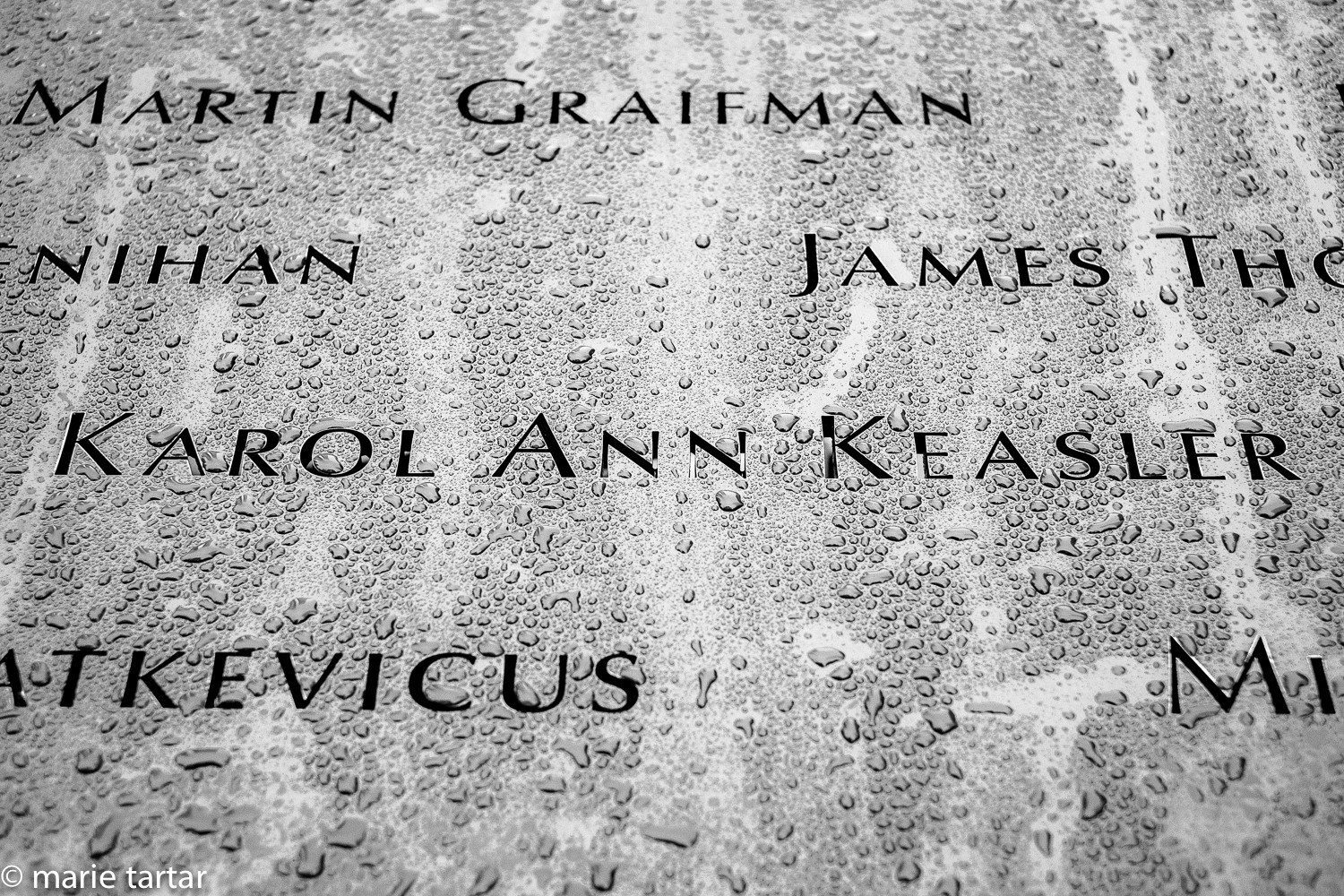
Names of the victims of the September 11th attacks are inscribed around the Memorial Pools, in the footprints of the Twin Towers
We texted Sarah for a lunchtime suggestion and she steered us to Blue Smoke, a BBQ restaurant which turned out to be right next to the theatres in which we were going to spend the afternoon and evening, Regal Cinemas Battery Park. We thoroughly enjoyed sharing a fennel and radish salad, buttery and savory cornbread madelines, and a side of collard greens with potlikker, with roasted oysters for me and a 7 pepper brisket sandwich for Steve.
Our introduction to the Tribeca Film Festival was 3 consecutive films taking us from afternoon to evening. Much like the Sedona Film Festival, the films are timed such that there is roughly an hour between films, not really enough time to do much else or eat.
“Franny” starred Richard Gere as an old-money Philadelphia philanthropist insinuating his way into a young expecting couple’s life. The expectant mother, played well by Dakota Fanning, is the daughter of Franny’s deceased best friends. Franny has unacknowledged issues with addiction, stemming from the accident which killed his best friends. It was quite well done, an interesting depiction of addiction and obsession.
Our second film, a documentary, “Peggy Guggenheim, Art Addict” by Lisa Vreeland, was a portrait of a fascinating art world figure whose emotional and financial support through friendships and her galleries was instrumental in nurturing the careers of many significant mid-century artists, notably Jackson Pollack.
I always try to choose a comedy for a later film. Dirty Weekend by Neil LaBute filled the bill well, starring Matthew Broderick and Alice Eve as co-workers unexpectedly stranded in Albuquerque. Dirty weekend apparently is an English phrase denoting a weekend away from home, during which sexual peccadillos might be explored. Matthew Broderick is a straight-laced married man who can’t quite remember all the details of an unusual sexual encounter he had the only other time he was in Albuquerque, while his co-worker has relationship issues of her own.
We walked home along the west side highway, alone, in the fog, with New Jersey looking unusually beautiful in the distance.
Tuesday, April 22, 2014
I met up with my sister for breakfast at Chalait, a few blocks away, a sunny corner spot in the perennially confusing Christopher Street-Sheridan subway stop multi-way intersection. We sipped matcha lattes and munched avocado toasts while catching up.
Clarissa walked back with me to check out the hotel. Steve was waiting in the lobby, in anticipation of our departure for Soho a few blocks south, and our 1 pm appointment at the Judd Foundation. Donald Judd bought the 5 story cast iron industrial building in 1968 for $68,000, and used it as his home and studio until his death in 1994 , splitting time between NY and Marfa, Texas. We had visited Marfa years back with former MOPA curator Carol McCusker and the Eye for Art group, and had loved his streamlined vision of art within architectural spaces (he hated being characterized as a minimalist). Sadly, photography isn’t permitted, but suffice to say that any architecture or contemporary art buff would not want to miss visiting this site. Our guide, Leah, is a working artist, and we enjoyed her outline of Judd’s life and work, and commentary on Judd’s art collection, including works by contemporary artist friends Carl Andre and Frank Stella. The Stella apparently came from Philip Johnson’s collection, in exchange for a site-specific work which we had previously seen at the Glass House.
While stopped in Ottiva, a favorite Italian shoe store on Spring Street in Soho, wrapping up shoe-boots for Steve, we asked the proprietor if he had any recommendation for lunch. He suggested the Sicilian place next door, Piccola Cucina, which was a tiny place with an enticing lunch special: all the pastas were $10! We shared tagliatelle with wild boar and spaghetti with sardines, raisins and pine nuts, as well as a fennel and orange salad.
Then it was time to head back to the hotel to change for Broadway opening #2 of the week: Doctor Zhivago. Retarding our progress was walking back via Washington Park, ablaze with blossoming pear trees, luring New Yorkers out to lounge in the sun.
For this opening, I wore a charcoal grey Manrico cashmere knit dress under a calf-length silver Issey Miyake pleated coat, with red satin belt, accompanied by red pumps and origami bag.
San Diego and La Jolla Playhouse were well represented at the pre-party at Flute, a champagne bar on 54th St. At the theatre, it was a hubbub of excitement, with spectators craning their necks and hoisting their cameras into the air to see what celebrities were alighting onto the step and shoot backdrop. Based on my experiences seeing the 2005 Page to Stage and follow-up LJ Playhouse versions of Doctor Zhivago, I had come prepared, my small evening purse half-filled with a full travel packet of tissues. These were nearly exhausted by the end of the performance, a mushy collection of tear-sodden wads. Yes, I bawled, just like at the 2 prior performances I saw years ago. I’ll admit I’m a soft touch. We had a good view of the pageantry of the choreography from our first row first mezzanine seats.
The story is epic in scope, taking place as it does during the Russian Revolution and subsequent civil war. Lara and Zhivago were beautifully sung by Tam Mutu and Kelli Barrett.
Perhaps I should have had a second packet in reserve, for later, reading the reviews of Zhivago, which were disappointing. I had been surprised to learn on this trip that the reviews are already written by opening night, and published that night. The show may be continuously tweaked during previews, but is “locked” a few days before opening night, during which period reviewers see the show and write their reviews, which are ready to go on opening night. Staying up late reading glowing and rave reviews of Fun Home was certainly a lot more fun than reading the Zhivago reviews. I made the mistake of peeking at Zhivago’s reviews while still at the party, which definitely deflated my party mood.
In a continuing episode of my global Book Club (I had lunch with 2 friends from my San Diego book club in Paris in March), one of the SD notables who was at the Zhivago festivities was my fellow book clubber, Mary Walshok. I heard another member, Roseanne, was there as well, but didn’t run into her in the throng at the theatre or after-party. Another book club friend, my former French conversation classmate, Roz, was driving into the city the following day to hang out with us for the afternoon.
It was wonderful seeing Roz again, over a year after she moved away from San Diego. We met at City Bakery on 18th street, which we love for the wonderfully varied and fresh salads, not to mention the thick hot chocolate, so rich a shot glass size is plenty, and the pretzel croissant, a crispy, sesame seed-studded and savory twist on a croissant. After catching up on her new life in Bovina in the northern Catskills, launching her digital publishing endeavor and work in B film making with boyfriend Chris, we took advantage of still good weather to walk some of the Highline, which was new to Roz and enhanced by spring blossoms and flowers. We dropped down to the street level to see Alison Rossiter’s show at Yossi Milo gallery and fell in love again with her luscious, minimalist photographic, camera-less creations using out of date film papers. The predicted rain started up while we were in the gallery chatting with Yossi and Alissa and drooling over new work by Alison, and then all too soon, it was time for Roz to head back home.
Our evening’s entertainment was Speedy, a brilliant 1928 Harold Lloyd silent film classic directed by Ted Wilde, set in NYC and featuring some of the most hair-raising chase scenes I’ve ever seen. It was hilarious, with priceless scenes at Coney Island and with Babe Ruth as a back-seat taxi passenger en route to the ballfield. The Coney Island sequence gave new import to the phrase “having crabs.”
This was a world premiere of the Criterion Collection restoration, and had a most unusual and effective live sound track, a DJ named Z-Trip. A trip it was, with hip-hop, nostalgic riffs and everything in between, mixed and mastered in a spot-on accompaniment. The only detraction was the rock concert-level volume. Thankfully, I had a pair of ear plugs for me and a set of earbuds for Steve, which brought the decibel level down to where I could really enjoy the pairing.
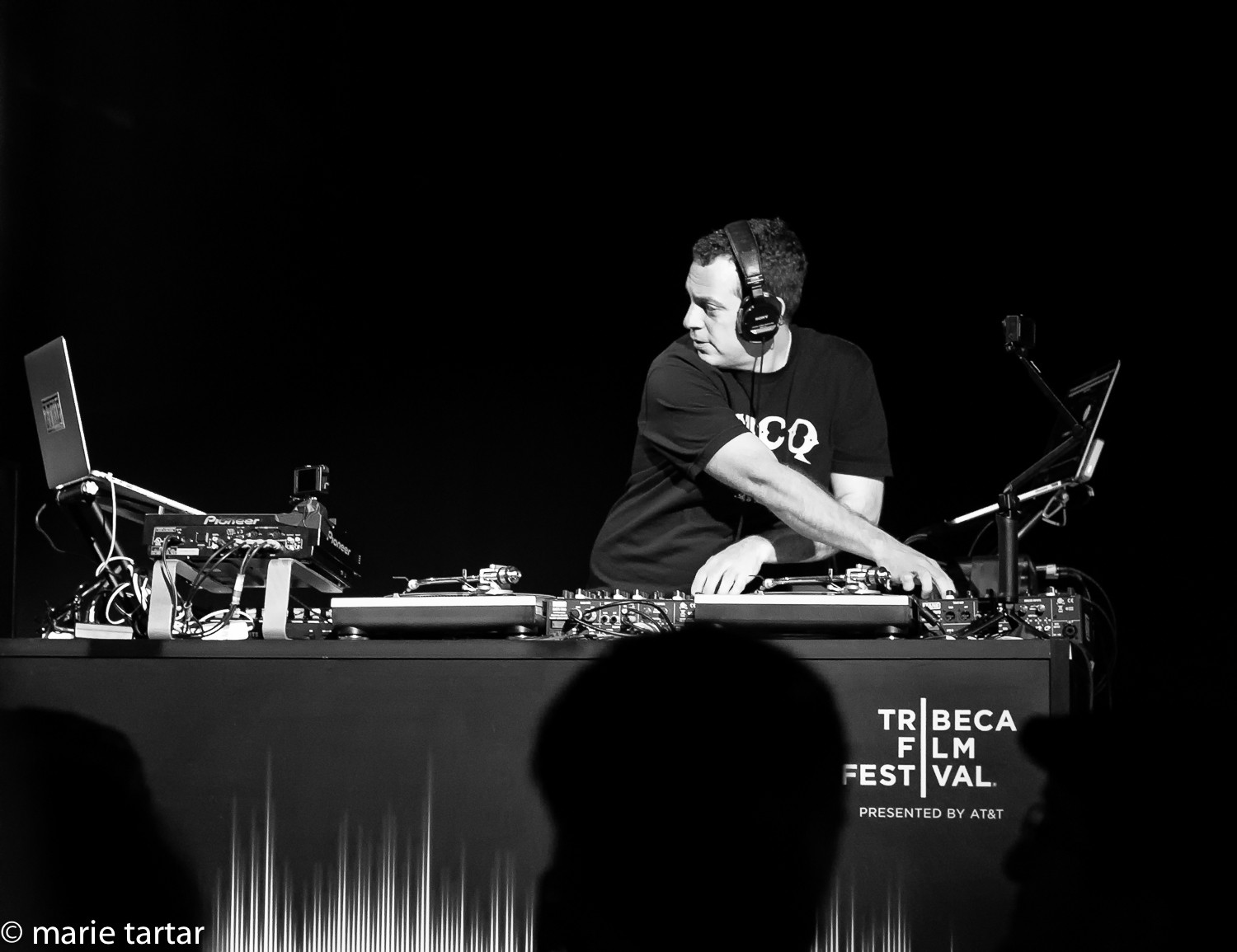
DJ Z-Trip provided a live and exhilarating accompaniment to the silent Harold Lloyd classic, “Speedy,” at the Tribeca Film Festival
There was a panel discussion afterwards, including Harold Lloyd’s granddaughter and DJ Z-Trip, from which we learned more about Harold Lloyd. In the 1920s, he was the most popular movie star in America. He is less well known today than contemporaries Charlie Chaplin and Buster Keaton, largely through insistence that his films be accompanied by pipe-organ, and not piano. As organs became less and less available in theaters through the decades, his films were shown less and less. Among connoisseurs of silent films, he holds his own with these giants. Speedy was his own personal nickname. The film cost $700,000 to make, but made $2.5 million. Filming in NY took place over 12 weeks.
We walked home by way of Washington Square, heading to an old favorite for a late snack: Dumpling Man in the East Village, worth the walk in the cold for the warming and savory seared house-made dumplings.
Thursday was marked by an abrupt return to winter, quite cold, windy and grey. We were warmly welcomed for tea at the penthouse apartment of future exchangers Kathleen and John in Tribeca, practically next door to where we stayed on our last visit to NYC at Hotel Hugo.
When we were stayed before in that neighborhood, we were always passing an intriguing storefront, either too early or too late. It was filled with gorgeous pieces of furniture, with NY prices to match (Nakashima headboard for $68,000 being one example). They did give us a good steer for lunch, The Greek, just down the street, sharing a fava bean spread, gigantes and artichoke moussaka.
We returned to Regal Cinemas in Battery Park afterwards for “Lucifer,” a strangely hypnotic film shot in an unusual round format the director calls Tondoscope. In line, we had an animated conversation with a nice man from Cuba, who was thrilled at the upcoming prospect of JetBlue service from NY to Havana and gave us several restaurant recommendations.
Ordering drinks at the refreshment stand, a cider for me and a beer for Steve, was brought to a standstill by Steve not having ID with him.
“You’re carding him? He has white hair,” I pointed out, helpfully, to no avail. No, I couldn’t buy drinks for both of us, there is a 1 drink per person limit. The woman behind me whispered that she would order Steve his beer, so I slipped her the money.
After a reprise of our lunch at Blue Smoke, we saw our favorite of the new films we saw during the week, “Applesauce, “ a funny black comedy set in motion by a radio DJ’s confessional program asking “What’s the worst thing you’ve ever done?” Two couples who are friends find their lives further intertwined and turned upside down when writer/director Onur Tukel (playing lead character Ron) confesses to his wife and friends his worst action.
The after-film discussion included the director, producers, multiple cast members and even a student intern (“Hi, mom and dad”) and to kick off the discussion they offered door prizes for the first 2 questions. I took advantage of the offer to ask what was on my mind, namely what did the title signify? I was relieved to learn there hadn’t been a reference in the film I had missed. The apple was a reference to the Big Apple, where the film takes place, and applesauce, the scrambled version reflecting the shuffling of partners and upending of lives that takes place in the movie. Apparently, applesauce also was a mild expletive during the 1920s, more colorful than “Darn!” For my question, I received a DVD of the director’s earlier film “Summer of Blood,” which several commenters mentioned along the lines of “Applesauce” being SO much better. I did enjoy Applesauce enough that I am really looking forward to viewing this horror comedy vampire film back home.

Writer, director and actor Onur Tukel (2cd from right) fields questions from the audience after the screening of “Applesauce” at the Tribeca Film Festival, accompanied by 4 other actors from the film and an intern (2cd from left).
Multiple comparisons of Tukel were made to Woody Allen during the discussion, which seemed quite apt. He is a funny, bearded, obsessive, rumpled New Yorker of Turkish descent whose character, a high school teacher, grapples with larger questions while trying to connect with his students.
As for comparing Tribeca’s to Sedona’s film festival: both were well organized, with excellent variety of films and friendly staff and participants. The only major difference we noted was that there was a director (or panel equivalent in the case of “Speedy”) present at every single one of the 6 films we saw, no doubt reflecting the fact that likely many of the directors are based in NY.
Wanting to share some of Doctor Zhivago swag I received at the after-party, including bullet-shaped tubes of “Russian Red” MAC lipstick, I lunched with Clarissa at Via Carota in the West Village, sharing a delicious green salad with fresh fava beans, grilled funghi on smoked scamorza cheese and gnocchi in a gorgonzola cream sauce.
Afterwards, I walked north with her to her work in mid-town, peeling off at MOMA to see the show One Way Ticket, featuring the entire 60 panel painting Jacob Lawrence Migrations Series from 1940-1. The themes resonated perfectly with those in the book I was reading for our upcoming book club, Jacqueline Woodson’s Brown Girl Dreaming, a book-length prose poem. The “Other Visions of the Great Movement North” portion of the show featured related publications and music pieces, including Billie Holiday singing “Strange Fruit” and Marian Anderson in concert in 1939 at the Lincoln Memorial before a massive crowd of 75,000 filling the Mall. This open air concert resulted after the Daughters of the American Revolution refused permission for Anderson to perform at Constitution Hall, prompting First Lady Eleanor Roosevelt to resign from the DAR and to intervene.
Steve was talking to a colorfully attired woman at Columbus Circle when I arrived.
A young man from Mali tried to talk me into a pedicab tour of Central Park. He became very animated when I switched to French on learning he was from Mali.
From there, we walked to Yakitori Totti , a favorite for the perfect light pre-theatre meal, grilled mini-skewers of scallops, asparagus, okra, shitake mushrooms, miso-glazed eggplant rounds and shishito peppers, rounded out by sizzling gyoza and salmon onigiri and pickles.
Beautiful, the Carole King life story musical, was wonderful. Why I wanted to see it, in one word: Tapestry. Tapestry was one of the first albums I bought for myself. I was in high school, and it was summer of the Bicentennial, 1976. I heard on the local radio station that the winner of a contest for the best bicentennial trivia would get to pick out 10 albums of their choice at a record store. This sounded like a contest with good odds to me, not likely to attract a lot of entrants and so off to the library I went, this being well before the Internet became the first stop on the search for information.
I don’t remember what arcane fact I entered but I did win, and thus I was able to pick out 10 whole albums of my choice. Some of my choices were classics: Fleetwood Mac, Jackson Browne. In those days, one could just about literally wear out an album by listening to it so much, and Tapestry was one of those albums for me.
Evidently, there are a significant number of people like me, enough at least to pack the theatre with delighted listeners, over a year after the show opened and even after the departure of the Tony winning star who originated the role. The lead played by Chilina Kennedy was fantastic, her voice inhabiting Carole King’s lush lyrics and tonalities.
On Saturday morning of our departure, we headed to Soho for brunch at Hundred Acres with Sarah and Aaron. Aaron had just finished an overnight shift a few hours before and had to work again that evening, so we were touched he was willing to sacrifice much needed sleep to meet up with us again. We shared some scrummy starters, beignets (creamier than the New Orleans variety, hot and delicious) and deviled eggs topped with salmon roe or crawfish. Aaron and I both had the chiliquiles with scrambled eggs, with a very tasty verde sauce.
Not well known, but right in Soho are two large-scale art installations by Walter de Maria, just a couple of blocks apart. They were commissioned by Dia Art Foundation and are startling site-specific works, which are free, but surprisingly little known, even to New Yorkers. This seemed the perfect opportunity to check them out. Photography isn’t allowed (the recently deceased artist’s preference).
The New York Earth Room dates back to 1977 and has been on view since 1980. It is “an interior earth sculpture,” essentially a large (3600 square foot) space filled 22 inches deep with 250 cubic yards of earth weighing 280,000 pounds. This is installed on the second floor of a non-descript building. What these numbers don’t convey is the darkness and fecundity of the soil, the drop in temperature and subtle rise in humidity as you approach the viewing area. There apparently were 2 prior Earth Room sculptures, both in Germany, in 1968 and 1974, neither extant today.
While impressive in scale and improbability, the New York Earth Room is somber and sterile. The Broken Kilometer of 1979 is quite a beautiful installation, 5 parallel rows of 100 2-meter-long highly polished brass rods filling a large space at 393 West Broadway. They stretch away into the unapproachable distance in a stunning array.
Strangely, these 2 art installations were actually the second set of artworks featuring earth and golden rods we had seen this week. Just before ascending to the Highline 2 days earlier with Roz, we had stopped into Hauser & Wirth Gallery, which was featuring a show by a Delhi-based Indian artist, Subodh Gupta, Seven Billion Light Years. The number 7 billion references the earth’s population. One of the featured works was a large earth work, entitled Pure (I), in which household objects, gathered from Gupta’s neighbors, were embedded in a field built up of mud and cow dung. After donning surgical shoe covers, viewers could walk onto the artwork to see the objects otherwise concealed.
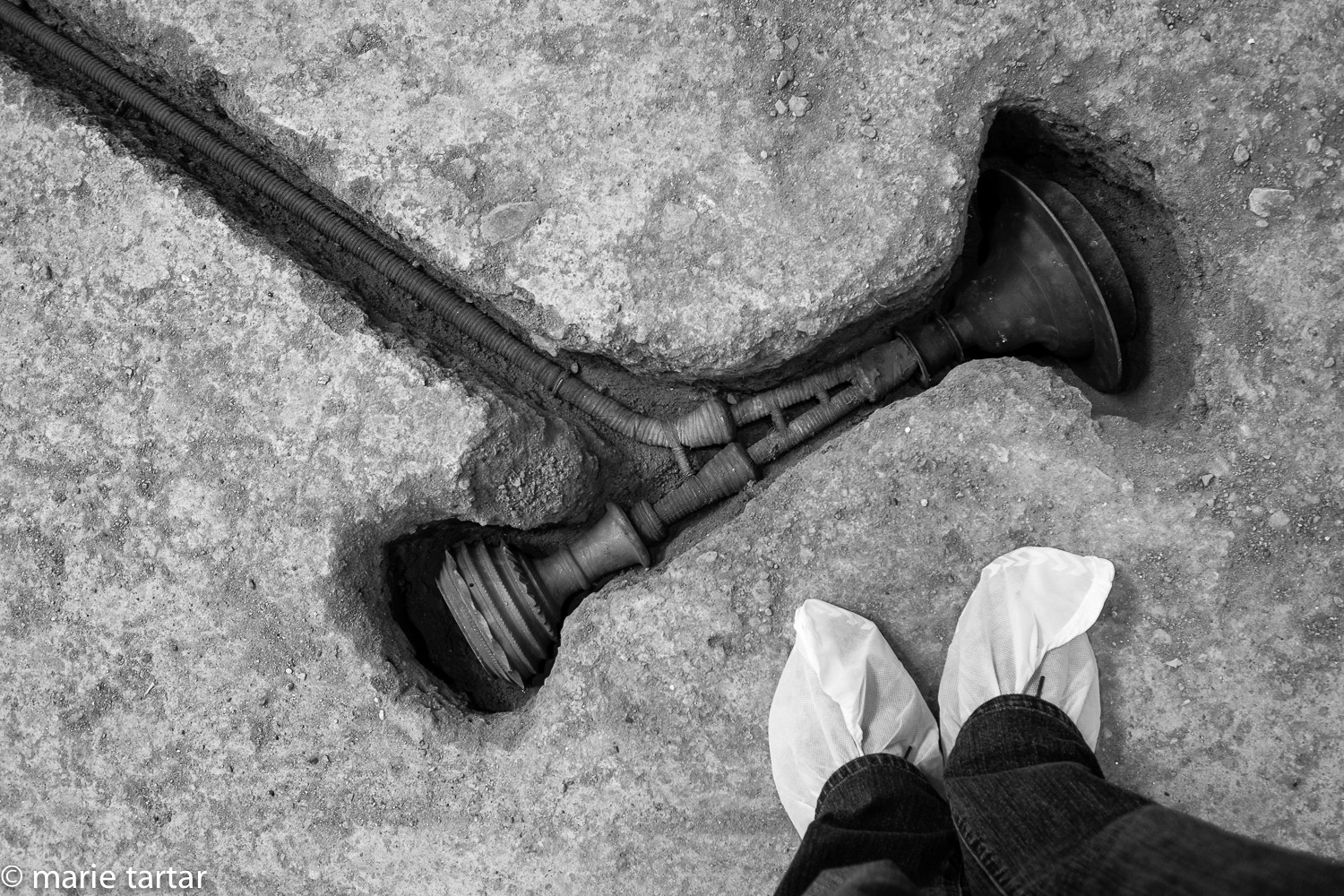
Earth work made of mud and cow dung, believed by Hindus to have purifying properties, built up in an art installation, Pure (1) by Gupta. Embedded tools contributed by the artist’s neighbors in India can be viewed after donning shoe covers and climbing up onto the miniature field
A nearby exhibition of black and white photographs documented the people who contributed tools and other objects embedded in the field.
Golden rods were a major component of Imperial Metal, a work of 2014.
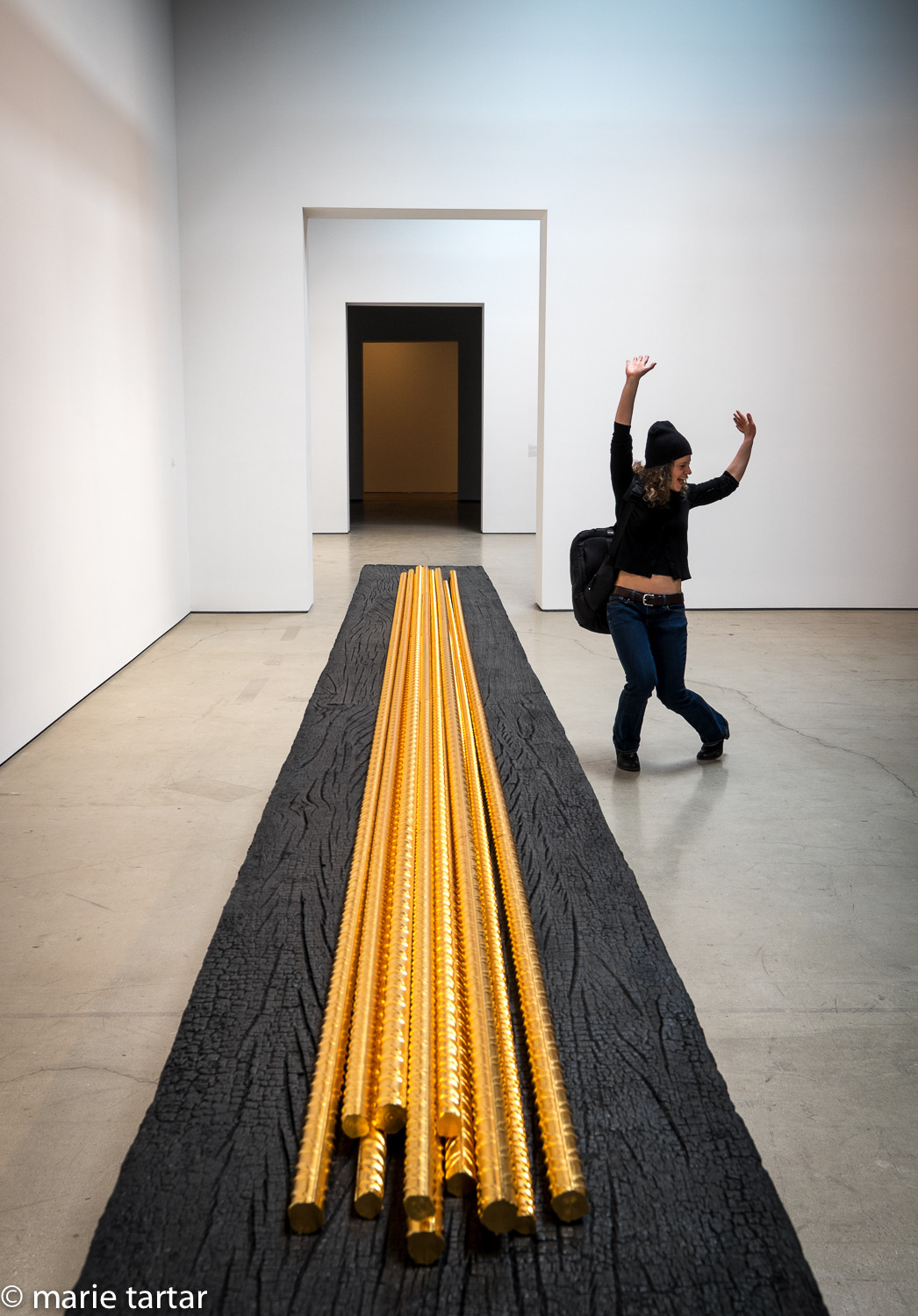
Roz does a Vanna White number at Hauser & Wirth Gallery in Chelsea, extolling the virtues of a 2014 work by Subodh Gupta, Imperial Metal
We weren’t familiar with this artist’s work, but found it visually and conceptually interesting, incorporating ordinary household objects into unusual installations. One large gallery was filled with a giant jumble of metal household cooking pots, a 2011 work entitled “This is not a Fountain.” In another, 3 huge round bristly wall-hung sculptural works proved to made up of innumerable pairs of tongs.
Sarah and Aaron enlivened our trip to JFK with a stop at the actual Coney Island, which was reconstructed after being severely damaged by Hurricane Sandy in October 2012.
Days earlier, we had loved seeing Harold Lloyd and Ann Christy in “Speedy”, taking in all the pleasures of a day at this iconic amusement park. There were delightful complications, including an unusual case of “crabs.”
I’m continually amazed by New York. No matter how many times I’ve been there, every trip is different, with new neighborhoods and artworks and parks to be explored, and old favorites to be enjoyed again. An embarrassment of riches, a continually changing mosaic, a patchwork quilt of new and old, hip and classic, with something for everyone.
Post-script: While polishing this post for publication, we received heart-breaking news, another plunge on the emotional roller coaster. After being pummeled by reviewers, shut out for Tony nominations and with lack-luster ticket sales (despite reports of wildly enthusiastic audience reception), we learned Doctor Zhivago would close on May 10, only weeks after opening. We’re hopeful it will find a more receptive national and international audience who will better appreciate its old fashioned but still relevant themes. On the flip side, Fun Home received 12 Tony nominations and is enjoying excellent box office sales. We found Onur Tukel’s earlier Tribeca submission, S.O.B. (Summer of Blood), the horror comedy vampire flic, absolutely hilarious!
-Marie
To see more of our images, click on this link



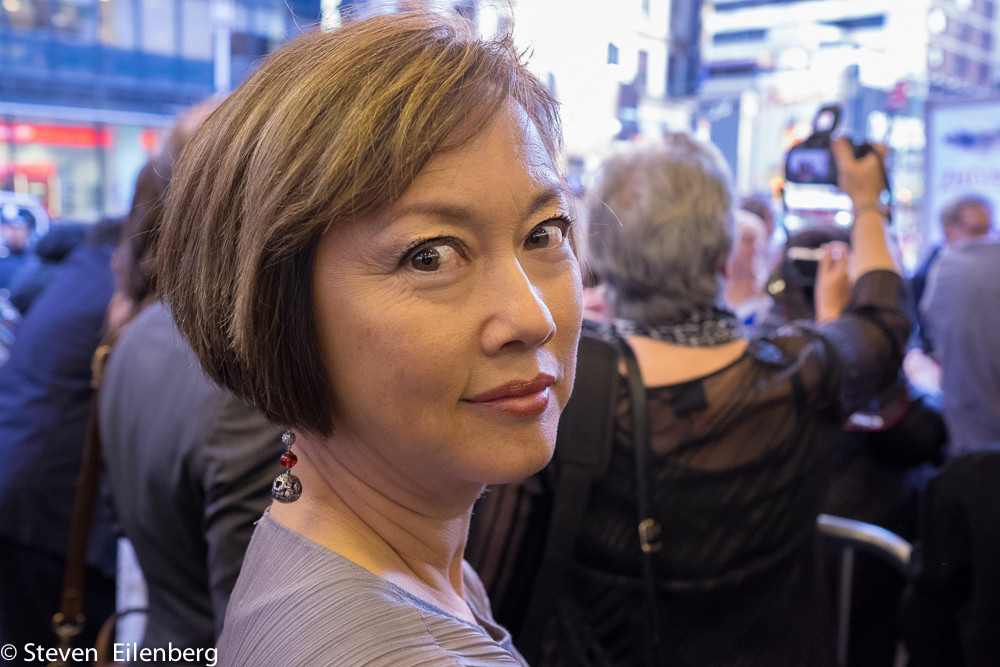
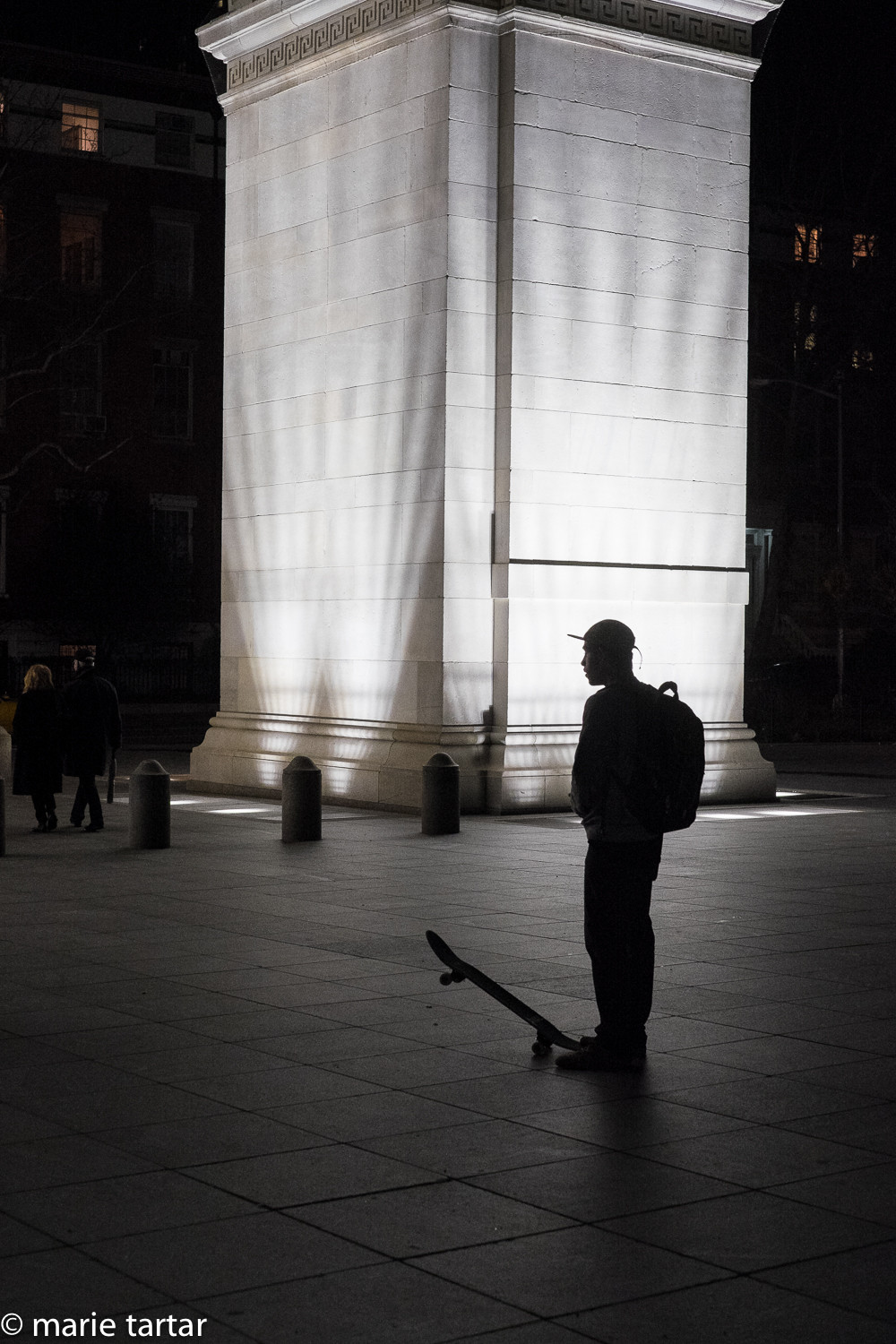
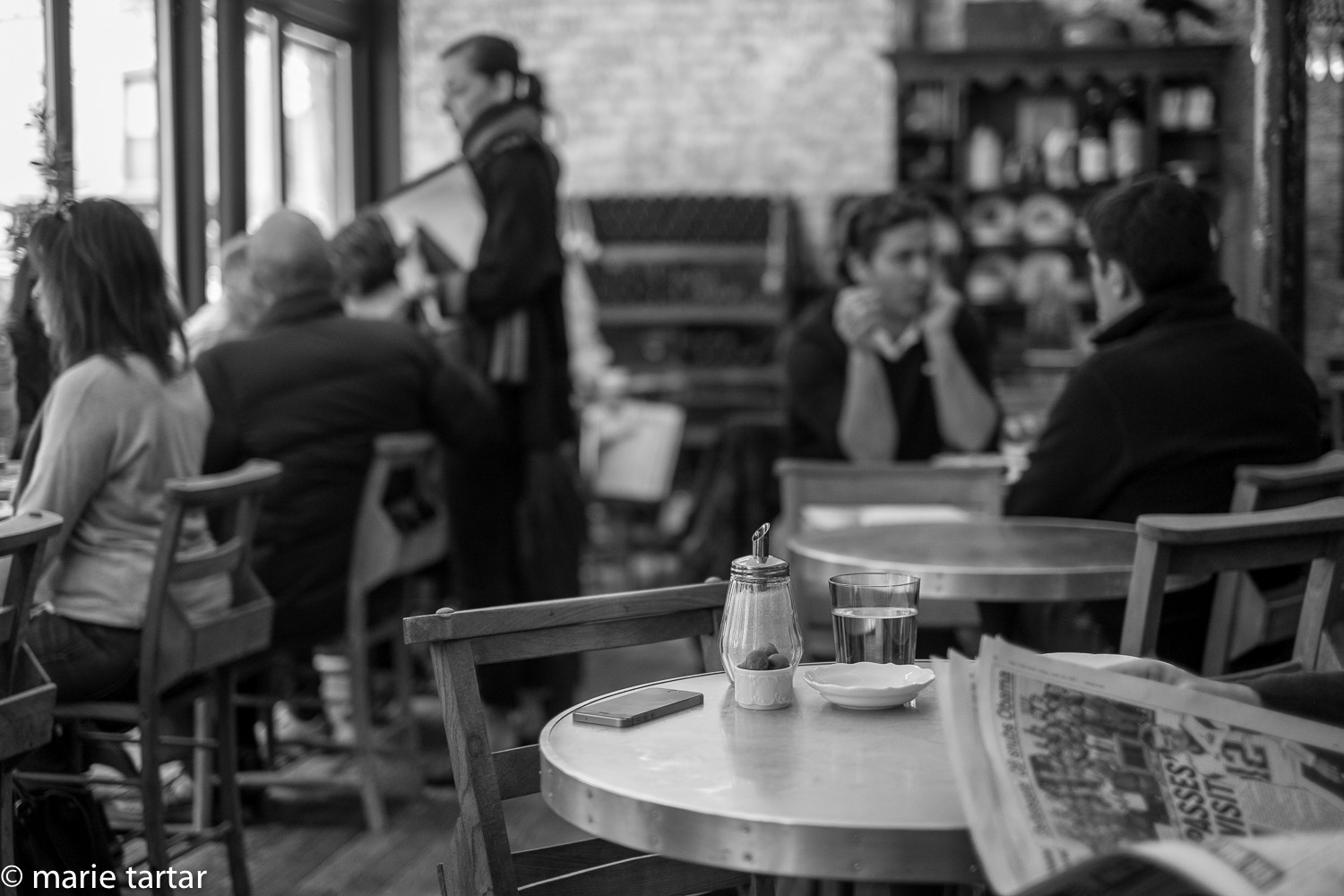

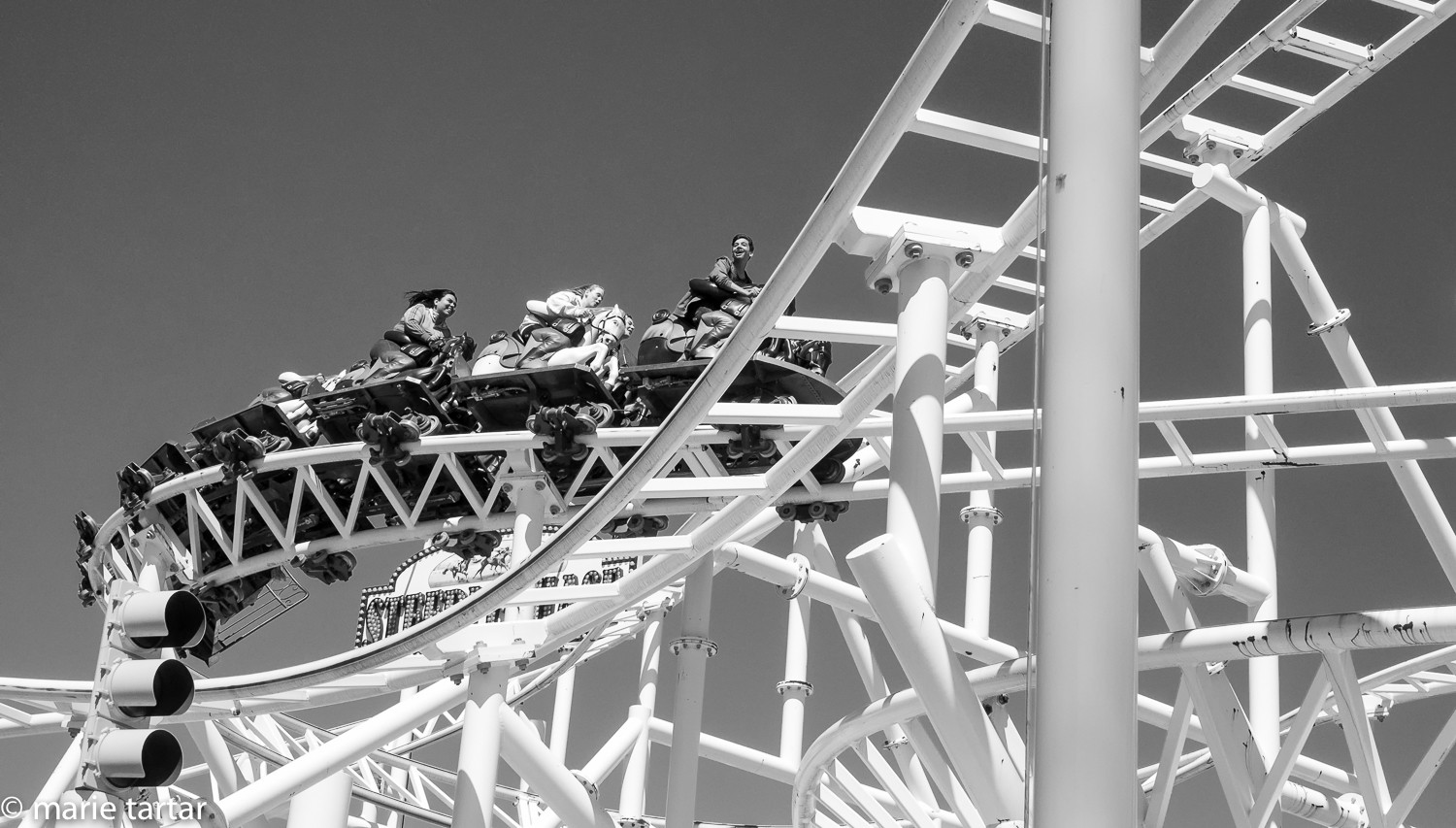
Marie & steve
Thanks for your interesting blog and photographs. I visited ground zero in October so was happy to see your shot of the progress of Calatrava’s Transportation Center. Please keep me traveling vicariously.
My daughter, Mary and I additionally went to the Metropolitian Opera to “Macbeth” and to my friend’s daughter’s off off Broadway play opening night and party. Another of our highlights was a journey to Storm King Art Center where 200 world renound sculpture is on view on several hundreds acres of land. We took two full days to see as many sculptures as we could and rewarded ourselves by dining at Blue Hill Farms 22 Courses With wine Parring’s (10 pm to 2 am) sigh! Hugs Suzanne Applebaum
Great to hear from you Suzanne, We love Storm King as well! 22 courses? That might well be a record for us! Love, M & S
Hey – great blog, just looking around some blogs, seems a really nice platform you are using. I’m currently using WordPress for a few of my blogs but looking to change one of them over to a platform similar to yours as a trial run. Anything in particular you would recommend about it?
Hi Andy, I’m not an expert, but did take the advice of my website designer, who is. I am happy with the ease of uploading new material, and both me & my husband found the learning curve fairly easy. But you probably already know that! Best, Marie